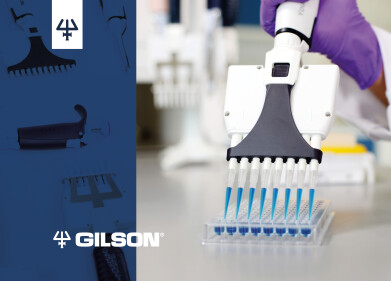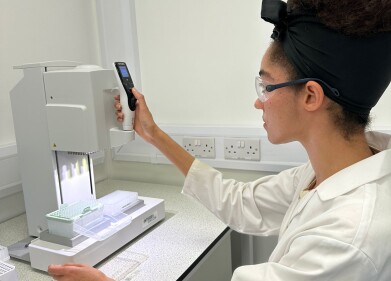-
 Appropriate equipment maintenance is essential for accurate pipetting results.
Appropriate equipment maintenance is essential for accurate pipetting results. -
 Correct pipetting techniques and careful handling can help to prevent damage caused by excessive wear.
Correct pipetting techniques and careful handling can help to prevent damage caused by excessive wear. -
 Pipettes are an important tool in any research laboratory, so are worth the added care to ensure they continue to work smoothly.
Pipettes are an important tool in any research laboratory, so are worth the added care to ensure they continue to work smoothly.
Pipettes
How to guarantee your pipettes lead long and happy lives
Mar 22 2022
Author: Marlene Frank, Integra Biosciences
Choosing a career in life sciences research is usually the result of a limitless curiosity and a desire to solve problems - not because of a passion for pipettes. However, day-to-day work in a research facility often entails hour after hour of transferring precise volumes of liquids, because it’s a fundamental aspect of many routine lab processes. Obtaining accurate results from this repetitive task depends on both operator technique and appropriate equipment maintenance.
Careful pipette upkeep and handling can be overlooked due to the ever-growing workloads and time pressures associated with modern research laboratories. This can cause excessive wear and tear, lowering the quality of results over time and leading to costly repairs. However, all is not lost. This article provides comprehensive guidance on how to best care for your pipettes - including everything from proper storage to regular calibration, and all things in between.
How to store a pipette
Correct pipetting techniques and careful handling can help to ensure accurate results and prevent damage caused by excessive wear. However, many researchers don’t realise that appropriate storage can be just as important. Implementing some of the tips below may add a few extra seconds to your working day, but could significantly increase the lifespan of your pipettes.
Always use a pipette stand
Storing pipettes on a stand doesn’t just keep your laboratory workspace neat and tidy - it can also help to protect equipment from potential spills or accidently being knocked onto the floor. Some stands also double up as charging stations, so using them when your electronic pipettes are not in use will help to ensure that they won’t run out of power. In addition, laying a pipette down on the bench can lead to several further problems. Firstly, piston lubricant may accumulate on one side, which can subject equipment to avoidable deterioration. Pistons can also become misaligned, compromising calibration. Lastly, any liquid remaining inside a pipette can run into the body, resulting in unnecessary corrosion and damage.
Remove tips
Pipettes should never be left with a tip attached, even if simply putting it aside for a few minutes. This is because any remaining liquid residue inside the tip could evaporate into the body of the pipette and cause internal damage.
Set to maximum volume
You should always set manual pipettes to their maximum volume once finished. This allows the spring to return to its least stressed position, further increasing the lifespan of the pipette [1].
How to clean a pipette
After successfully completing a series of experiments that has taken weeks or months of work, most people immediately start to think about their next project, not the task of completely dismantling and thoroughly cleaning their pipettes. However, this shouldn’t be put off for too long. Pipettes are one of the most important tools in any research laboratory, so are worth the added care to ensure they continue to work smoothly for the longest possible time.
Exterior
Cleaning the outer surface of a pipette is quick, simple and can effortlessly become a part of your daily routine. Wiping the equipment with a lint-free cloth lightly soaked with 70% ethanol is usually sufficient, however it’s always best to check the chemical compatibility of pipettes beforehand.
Interior
Most manufacturers recommend that multichannel pipettes should only be disassembled and cleaned by those specifically trained to do so. However, anyone can and should regularly clean their single channel pipettes by following these simple steps [2-5]:
- Disassemble the pipette: Most models require the upper and lower parts to be disconnected before removing the O-ring and piston. However, operators should check specific operating instructions to learn how to fully and correctly disassemble their pipette.
- Swab with distilled water: Clean all the various components using a cotton swab soaked in distilled water - ensuring clogs in air passages are removed.
- Perform a maintenance check: It is important to check each component for visible damage, and replace any damaged parts, once clean. It is also recommended that O-rings and seals are replaced each time.
- Dry all components: All components should then be placed on a clean surface, and left to completely air dry.
- Grease the piston: Look at the operating instructions of each pipette to check what type of lubricant should be used, and where to apply it. Use a grease intended specifically for pipettes if no recommendation is provided, because other common lubricants have a variety of different compositions, and some may not be appropriate.
- Reassemble the pipette: All pipette components must be free of lint or dust particles prior to reassembly.
- Test your pipette’s functionality: A leak test and validation of the pipetting volumes should be undertaken to ensure that the pipette is working as intended after cleaning. A detailed step-by-step guide on how to do this can be found here.
Decontamination
Pipettes occasionally become contaminated with liquids, for example when users aspirate more liquid than the tip volume allows, when a pipette is placed on the bench with liquid inside its tip, or when unfiltered tips are used with RNA/DNA solutions. This can easily happen by accident, even when operators take the utmost care of their equipment, so it’s worth remembering these decontamination procedures.
Pipettes should be decontaminated immediately to avoid cross-contamination, following the cleaning procedure outlined above, as well as performing additional decontamination steps after disassembly.
Why regular calibration is essential
Even pipettes which are carefully handled, appropriately stored and regularly cleaned need to be regularly calibrated – every six to 12 months, depending on laboratory workflow requirements – by the manufacturer or a specialised company. Keeping up-to-date records of past calibrations helps to ensure the next date won’t be missed. Some electronic pipettes and pipette software packages even allow calibration reminders to be set, or the service history to be recorded, to help keep track.
Regular calibration will ensure that pipettes provide ongoing precision and accuracy, as well as allow early detection of potential problems. Issues can therefore be fixed before more costly repairs - or replacement - becomes inevitable. These simple guidelines can guarantee prime pipette performance and the provision of reliable results for years to come.
Conclusions
This article explains simple steps that all laboratory staff can implement today to keep their pipettes delivering continuous and prolonged accuracy, offering reliable results for years to come. The best way to guarantee optimal care is to ensure you have enough stands to store all your pipettes, and to set up a regular schedule for cleaning, maintenance and calibration.
If you still have unanswered questions about the handling, cleaning or calibration of your pipettes, don't hesitate to contact the experts at Integra Biosciences.
More information online
References
1. Bryant, S. (2017). How should I story my micropipettes? https://camblab.info/how-should-i-store-my-micropipettes
2. INTEGRA Biosciences (2020). EVOLVE Manual Pipettes Operating Instructions. https://www.integra-biosciences.com/switzerland/en/manual-pipettes/evolve#downloads
3. INTEGRA Biosciences (2020). VIAFLO Electronic Pipettes And VOYAGER Adjustable Tip Spacing Pipettes Operating Instructions. https://www.integra-biosciences.com/switzerland/en/electronic-pipettes/viaflo#downloads
4. Paul C. (2014). Take Care of Your Tools: How to Clean a Pipette. https://bitesizebio.com/20270/take-care-of-your-tools-how-to-clean-a-pipette
5. Koeman K. (2017). Pipette Maintenance 101: Learn How to Properly Clean Pipettes. https://ttelaboratories.com/pipette-maintenance-101-learn-how-to-properly-clean-pipettes
Digital Edition
Lab Asia 31.6 Dec 2024
December 2024
Chromatography Articles - Sustainable chromatography: Embracing software for greener methods Mass Spectrometry & Spectroscopy Articles - Solving industry challenges for phosphorus containi...
View all digital editions
Events
Jan 22 2025 Tokyo, Japan
Jan 22 2025 Birmingham, UK
Jan 25 2025 San Diego, CA, USA
Jan 27 2025 Dubai, UAE
Jan 29 2025 Tokyo, Japan


















